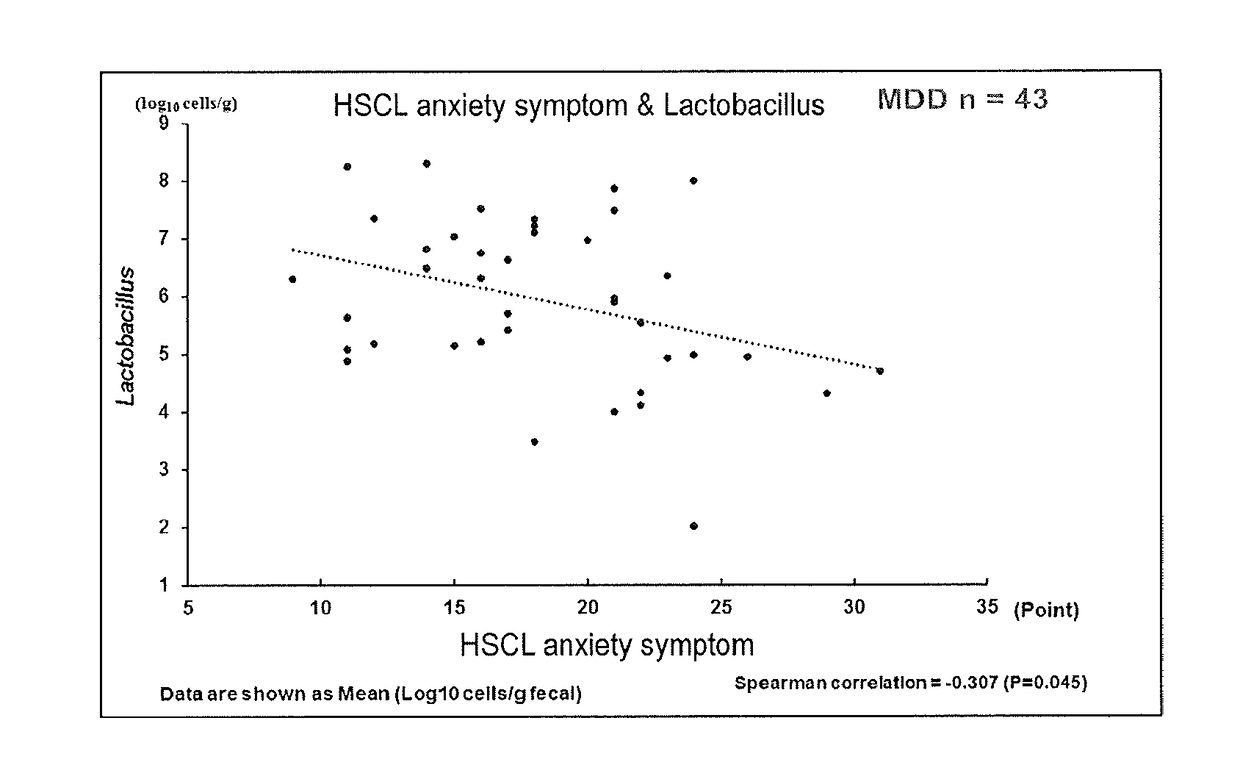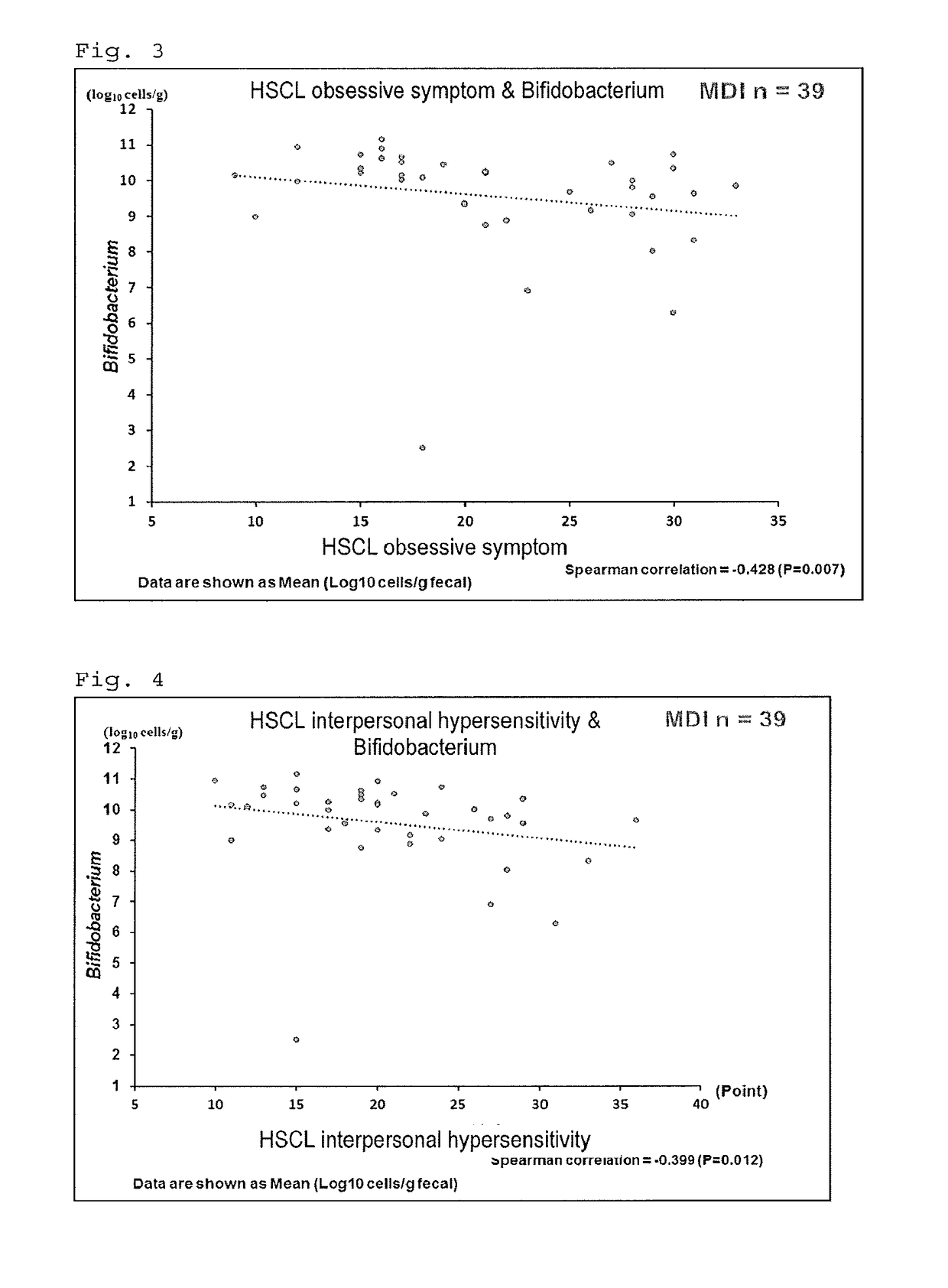Biomarker for mental disease
a biomarker and mental disease technology, applied in the field of mental disease markers, can solve the problems of increasing the number of patients with mental diseases, becoming a major social problem, and the accuracy of diagnosis has not yet been sufficient from the viewpoint of objective diagnosis, and achieve the effect of non-invasiveness
- Summary
- Abstract
- Description
- Claims
- Application Information
AI Technical Summary
Benefits of technology
Problems solved by technology
Method used
Image
Examples
reference example 1
[0136]Preparation of specific primers for Atopobium cluster, Lactobacillus, Lactobacillus brevis, Lactobacillus reuteri subgroup, Lactobacillus sakei subgroup, Bifidobacterium, Bacteroides fragilis group, Enterococcus, Clostridium coccoides group, Clostridium leptum subgroup, Staphylococcus, Clostridium perfringens and Enterobacteriaceae
[0137]Primers used to measure the number of cells of the above described enterobacteria are shown in Table 2. In addition, publications, in which individual primers are described, are also shown in Table 2.
TABLE 2SEQ IDTarget genePrimer nameSequence (5′ - 3′)NO:PublicationAtopobiumc-Atopo-FGGGTTGAGAGACCGACC1Aclusterc-Atopo-RCGGRGCTTCTTCTGCAGG2ALactobacillussg-Lcas-FACCGCATGGTTCTTGGCsg-Lcas-RCCGACAACAGTTACTCTGCC4Bsg-Lgas-FGATGCATAGCCGAGTTGAGAGACTGAT5Bsg-Lgas-RTAAAGGCCAGTTACTACCTCTATCC6Bsg-Lpla-FACCGCATGGTTCTTGGC7Bsg-Lpla-RCCGACAACAGTTACTCTGCC8Bsg-Lreu-FGATGCATAGCCGAGTTGAGAGACTGAT9Bsg-Lreu-RTAAAGGCCAGTTACTACCTCTATCC10Bsg-Lrum-FCTCTGGTATTGATTGGTGCTTGCA...
reference example 2
[0138]Preparation of calibration curve used in RT-PCR
[0139]A calibration curve, which was to be used upon quantification of the desired enterobacteria in a specimen, was produced. Specifically, according to the following procedures, a calibration curve was prepared by plotting the number of enterobacterial cells counted by a DAPI counting method on the horizontal axis and plotting the CT value on the longitudinal axis.
[0140]1) 400 μL of RNAlater (Ambion) was added to 200 μL of each strain solution prepared in the above “[1] Used strains,” and the mixed solution was then left to stand at a room temperature for 5 minutes. Thereafter, the reaction mixture was centrifuged at 13,000 g for 5 minutes, and a supernatant was then removed by decantation. Subsequently, 450 μL of a lysis buffer (which was prepared by mixing 346.5 μL of an RLT buffer, 100 μL of TE and 3.5 μL of β-Mercaptoethanol, for a single sample) and 300 mg of glass beads having a diameter of 0.1 mm (TOMY SEIKO CO., LTD.) we...
example 1
[0156]Relationship between Mental Disease and Enterobacterial Flora
[0157]The enterobacterial flora of a patient with a mental disease (depression, manic depression, or schizophrenia) was carefully investigated, and the relationship between such a mental disease and the enterobacterial flora was evaluated.
(1) Diagnosis of Mental Disease
[0158]A mental disease was diagnosed by a psychiatrist, using a mental disease mini-international neuropsychiatric interview MINI (Mini-International Neuropsychiatric Interview, Japanese edition: Otsubo T, et al. Reliability and validity of Japanese version of the Mini-International Neuropsychiatric Interview. Psychiatry and Neurosciences 2005; 59: 517-526.). Each patient was diagnosed healthy or with any one of depression, manic depression, and schizophrenia.
(2) Acquisition of Specimens
[0159]After completion of the diagnosis of the mental disease described in the above (1), feces obtained from the following patients were excluded from specimens.[0160]...
PUM
| Property | Measurement | Unit |
|---|---|---|
| Fraction | aaaaa | aaaaa |
| Fraction | aaaaa | aaaaa |
| Fraction | aaaaa | aaaaa |
Abstract
Description
Claims
Application Information
 Login to View More
Login to View More - R&D
- Intellectual Property
- Life Sciences
- Materials
- Tech Scout
- Unparalleled Data Quality
- Higher Quality Content
- 60% Fewer Hallucinations
Browse by: Latest US Patents, China's latest patents, Technical Efficacy Thesaurus, Application Domain, Technology Topic, Popular Technical Reports.
© 2025 PatSnap. All rights reserved.Legal|Privacy policy|Modern Slavery Act Transparency Statement|Sitemap|About US| Contact US: help@patsnap.com



